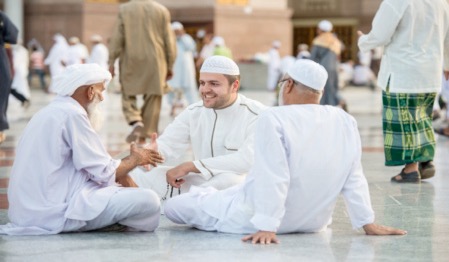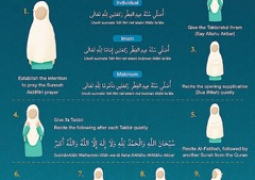
Says ‘Aishah, “The Prophet was sitting with his thigh exposed when Abu Bakr asked, and received, permission to enter. The same thing happened with ‘Umar. However, when ‘Uthman sought permission to enter, the Prophet covered himself with his clothes. When they left, I said, ‘O Messenger of Allah, you permitted Abu Bakr and ‘Umar to enter while your thigh was exposed.
When ‘Uthman asked permission to enter, you covered yourself with your clothes.’ He said, ‘O ‘Aishah, should I not be shy of a man who, by Allah, even the angels are shy of’?” (Related by Ahmad and al-Bukhari in mu’allaq form.)
Says Anas, “During the battle of Khaibar, the Prophet’s gown was withdrawn from his thigh until I could see its whiteness.” (Related by Ahmad and al-Bukhari.)
Says Ibn Hazm, “It is correct to say that the thigh is not part of the ‘aurah. If it were so, why would Allah allow His Prophet, who is protected (from sin), to uncover his so that Anas and others could see it? Allah would have kept him from doing this. According to Jabir as recorded in the two Sahihs, when the Prophet was young (before his prophethood), he was one time carrying the stones of the Ka’bah, wearing only a loincloth. His uncle al-’Abbas said to him, ‘O nephew, why don’t you untie your waistcloth and put it on your shoulder for padding?’ The Prophet did so and fell unconscious. He was never seen naked again after that.”’
Muslim records from Abu al-’Aliya that ‘Abdullah ibn as-Samit struck his thigh and said, “I asked Abu Zharr, and he struck my thigh as I struck yours, and he said, ‘I asked the Messenger of Allah, upon whom be peace, and he struck my thigh as I have struck yours and said, ‘Perform the prayer in its time...” Ibn Hazm said, “If the thigh was ‘aurah, why would the Messenger of Allah touch it?” If the thigh was ‘aurah according to Abu Zharr, why would he have struck it with his hand? The same can be asked for ‘Abdullah ibn as-Samit and Abu al-’Aliya. It is not allowed for a Muslim to strike with his hand another man’s pubic area, or the clothes over the pubic area. Nor can a man touch the clothing over a woman’s ‘a urah.
Ibn Hazm mentions that Hubair ibn al-Huwairith looked at Abu Bakr’s thigh when it was uncovered, and that Anas ibn Malik came to Qas ibn Shamas when his thigh was uncovered.
Reported Muhammad Jahsh, “The Messenger of Allah, upon whom be peace, passed by Ma’mar while his thighs were uncovered. He said, to him, ‘O Ma’mar, cover your thighs, for they are (part of the) ‘aurah.” This is related by Ahmad, al-Hakim and al-Bukhari in Tareekh and in mu’allaq form in his Sahih.
Reported Jurhad, “The Messenger of Allah passed by me when the cloak I was wearing did not cover my thigh. He said, ‘Cover your thigh, for it (is part of the) ‘aurah.” This is related by Ahmad, Abu Dawud and at-Tirmizhi, who called it Hassan, and by al-Bukhari in mu’allaq form in the Sahih.
Woman’s aurah & hijab
There is no such dispute over what constitutes a woman’s ‘aurah. It is stated that her entire body is ‘aurah and must be covered, except her hands and face. Says Allah in the Qur’an, “And to display of their adornment only that which is apparent (do not expose any adornment or beauty save the hands and face).” It has been authentically related from Ibn ‘Abbas, Ibn ‘Umar and ‘Aishah that the Prophet said, “Allah does not accept the prayer of an adult woman unless she is wearing a headcovering (khimar, hijab).” This is related by “the five,” except for an-Nasa’i, and by Ibn Khuzaimah and al-Hakim. At-Tirmizhi grades it as Hassan.
It is related from Umm Salamah that she asked the Prophet, “Can a woman pray in a long shirt (like a night shirt) and headcovering without a loincloth?” He said, “If the shirt is long and flowing and covers the top of her feet.” This is related by Abu Dawud. The scholars say it is sahih in mauqoof form (as a statement of Umm Salamah and not that of the Prophet.)
It is also related that ‘Aishah was asked, “In how many garments is a woman to pray?” She answered, “Ask ‘Ali ibn Abu Talib and then return to me and tell me what he said.” ‘Ali’s answer was, “In a head cover and a long flowing shirt.” This was told to ‘Aishah and she said, “He has told the truth.”
The clothes worn must cover the ‘aurah, even if they are tight enough to highlight those features. If the clothes are so thin that one’s skin color can be seen, they are not suitable for prayer.
Preferred to wear two garments in salat
It is preferred for a person to wear at least two garments, but he can wear just one if that is all he has. Ibn ‘Umar reported that the Prophet, upon whom be peace, said, “If one of you is going to pray, he should wear two garments, for Allah has the most right that you should look good for Him. If one does not have two garments, he should cover himself with a cloak when he prays, but not like the Jews do.” (Related by at-Tabarani and al-Baihaqi.)
‘Abdurazaq related that Ubayy ibn Ka’b and ‘Abdullah ibn Mas’ud had an argument. Ubayy thought it was permissible to pray in one garment, while Ibn Mas’ud said that that was allowed only if one had no other clothes. ‘Umar mounted the pulpit and said, “The correct position is: If Allah gives you more provisions, you should wear more clothes. A man can gather his clothes about him, or pray in a waist cloth and a cloak, or in a waist cloth and a shirt, or in a waist cloth and a caftan, or in trousers and a cloak, or in trousers and a shirt, or in trousers and a caftan, or in leather trousers and a caftan, or in leather trousers and a shirt.’ And I (a narrator) think he said, ‘Leather trousers and a cloak.”
Buraida reported that the Prophet forbade one to pray using an improperly-affixed sheet to cover his ‘aurah, and to pray in trousers while not wearing a cloak. (Related by Abu Dawud and al-Baihaqi.) It is related that when al-Hassan ibn ‘Ali prayed, he would wear his best clothes. He was asked about that and he said, “Verily, Allah is beautiful and He loves beauty, so I beautify myself for my Lord.” Such a view is in accord with Allah’s words, “And wear your adornment for every prayer.”
Uncovering the Head During the Prayer
Ibn ‘Asakir related that the Prophet would sometimes remove his cap and place it in front of him as a sutrah. According to the Hanifiyyah, one can pray with his head uncovered. In fact, they prefer this if it is done out of a sense of humility and awe.’ّ There is no evidence whatsoever that it is preferred to cover one’s head while praying.
TO BE CONTINUED




